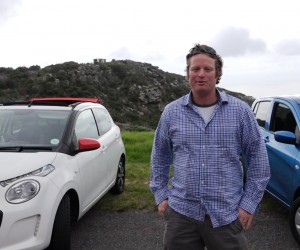The Citroen C1 Airscape is pretty much the same car as the Peugeot 108 and Toyota Aygo, with each individual manufacturer offering its own take on matters. In the case of the Citroen and the Peugeot, this means adding a full length, folding fabric roof in true European city-car style.
While it certainly adds something to the case for the car and it’s a much improved vehicle compared to its ancestral namesake, there’s some big named rivals in the class now who are offering much more highly-rated competition. So is the wind in your hair worth it?
The C1 Airscape is in almost all physical departments identical to the C1 so everything that applies to the hardtop car applies to the open-top one.
The interior is middle of the road quality, but it is at least bright and has a certain joie de vivre. The central floating pod containing the standard touch screen display can be selected with funky coloured trim. Although the range of options is a little more limited than the Peugeot, there are still some interesting choices to be had.
It’s a fun and lively city car to drive. The Citroen C1 Airscape has a 1.2-litre three-cylinder engine delivering 61kW and 116Nm. This may not sound like much, but when you consider the C1 Airscape weighs in at around 956kg, it gives it a respectable power to weight ratio. Fuel economy is what the C1 Airscape is all about and Citroen claims a combined cycle figure of 4.3L/100km. Thanks to its fun factor and zippy attitude, we were nowhere near this figure, but 6.9L/100km is still okay.
It loses marks due to its price (pushing 200k), which is quite large for such a vehicle. I’d put this cost down to a ridiculous exchange rate and import duties, which is a real pity as the world needs more cars with massive personality.
Frugal Suzuki
Meanwhile, the all-new 2015 Suzuki Celerio is one of the most affordable cars on the market – it starts from just R120 000 for the manual version. If you’ve never heard of a Celerio, the car’s predecessor – the Alto – may have a more familiar ring to it. If that still fails to register, this is the cheapest hatchback the Japanese brand sells.
It seems apparent that Suzuki has decided to offer more metal for your money with the new Celerio. The new model is notably larger than the Alto it replaces, measuring 3.6 metres long (up 0.1m), 1.6m wide (identical to the existing model) and 1.54m tall (up 0.7m). The wheelbase is also longer, spanning 2.42m (up from 2.36m).
The quality of the fit and finish dips away a little when you look closer, though, with the rear carpet of our test car fitted quite loosely, and the engine bay remained coated in primer with untidy blue overspray left for all to see.
Powering the Celerio is the same 1.0-litre three-cylinder petrol engine that was seen in the Alto, with outputs of 50kW (at 6 000rpm) and 90Nm (at 3 500rpm). A newly fitted continuously variable transmission (CVT) – replacing the Alto’s conventional four-speeder – sees fuel consumption drop from 5.2 litres per 100 kilometres to just 4.8L/100km.
On the highway the Celerio rolls along at about 3 000rpm at freeway speeds, though judging just how fast you’re going is a bit difficult – the speedometer on our test car was reading about 8km/h over, based on a GPS speed reader (and the fact the surrounding traffic seemed to be doing well over 120km/h, based on the speedo in the Celerio).
However, with inner-city buyers the main target, many Celerios won’t see that much out-of-town driving
Ciaz sizzle
Meanwhile, the new Suzuki Ciaz has been rated the most economical sedan in India, with a 1.4-litre naturally aspirated petrol motor. Fuel consumption in typical Suzuki fashion is excellent at 5.4L/100km.
It’s not the most powerful unit around, but it does come with 70kW and 130Nm which should get you by. Thankfully the Ciaz is pretty lightweight weighing in at 1 020kg for the manual five speed and 1 040kg for the four-speed auto.
The entry spec GL comes with a cloth interior where the GLX upgrades to leather upholstery with a leather steering wheel. The top GLX model also gets 16-inch alloys thrown at it and fog lamps bolted onto the front bumper. It comes in at R182 000, which is still cheaper than the smaller C1, and would suit a small family or businessman better.
You can’t really go wrong with any of the cars, if you’ve got the extra cash the C1 really does turn heads, with the bang for your buck stakes going to the Suzuki all day long – the more reliable car out of the two brands. Until next time, happy motoring.
Gregory Simpson

















